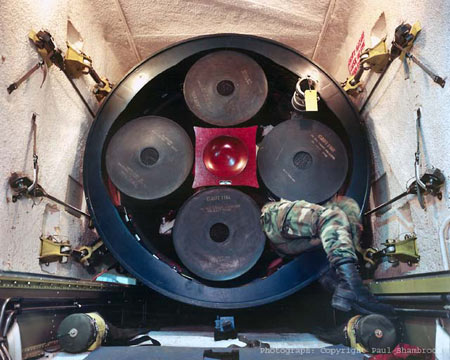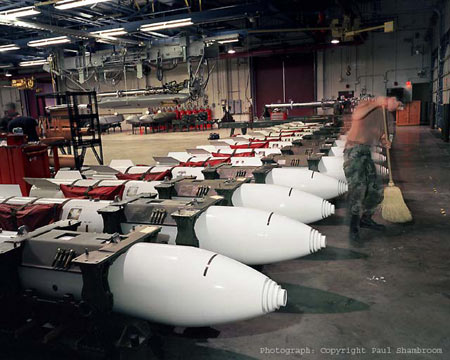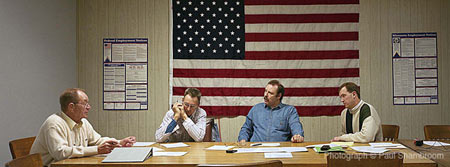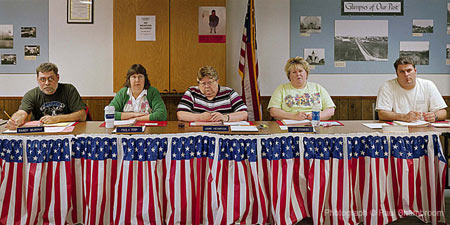A Conversation With Paul Shambroom

Paul Shambroom’s portfolio contains a series of projects that, on the surface, seem disconnected. But there is an underlying common theme. I talked with Paul about the connections and about the individual projects.
Jörg Colberg: Right on the front page of your website, it says that your work “explores power in its various forms”. Even though many - if not most - of our relationships are based on some arrangement of power I think that power itself is one of those things that not many people think about a lot (or at all). What was your motivation to start looking into power?
Paul Shambroom: It comes from the common photographic impulse to explore what is hidden. In my case, it was to see what is hidden beneath the surface of my own culture, as opposed to visiting other societies where I would be an outsider. I was also interested in the rise of conspiracy theory that was prevalent in the U.S. in the 1990’s, the notion that secret groups of powerful people were controlling our destinies. I never bought into these ideas, but I was fascinated by the feelings of powerlessness that seemed to drive them.

JC: Your Nuclear Weapons Series gives an overview of what the US’ arsenal looks like. I have always wondered how you managed to get permission to take those photos. I mean simply writing a letter like “Hello, I’d like to take photos of all the nuclear weapons that you have” to the military doesn’t really sound like a very good idea - or maybe that’s how it worked? How did you convince the people responsible for maintaining and guarding those weapons to allow you to take photos of them?
PS: I explain this in great detail in the preface to my book Face to Face with the Bomb: Nuclear Reality After the Cold War. In a nutshell, I’ve learned these things about successfully pursuing access:
- Do a lot of research and be very specific about what you’re asking for. Not: “Hello, I’d like to take photos of all the nuclear weapons that you have.” Instead “I’d like to visit the Weapons Storage Area at Barksdale Air Force Base in Louisiana for an unclassified photography visit between March and May of 1995, a full day would be ideal but 2 or 3 hours would work.
- Learn as much as you can about who the gatekeepers are and what the decision process is. Try to anticipate their objections and make a strong case for why their cooperation will benefit them as well as you.
- Be patient and persistent, don’t take rejection personally. If they turn you down, try to revise your proposal in a way that addresses their concerns.
- Establish your credentials with references from respected people, and emphasize your experience and credibility.
- Most important: Believe in what you’re doing, keep a positive attitude, and don’t be afraid to ask.

JC: Regardless of what we are supposed to believe, modern technology is quite a double-edged sword. While our lives have been vastly improved on many different levels, there is a dark underside to technology. One very obvious example is that we are currently polluting our own atmosphere to an extent that will alter the conditions of our lives, possibly in quite drastic and damaging ways. The dark side of technology is usually not easily visible, though, since it has only small, cumulative effects - with the possible exception of the kind of weaponry we are now able to produce and use. Nuclear weapons might be the most pernicious technology we have ever come up with. How did you go about taking photos of these weapons? To what extent did the sheer presence of those weapons right in front of you affect you?
PS: I really didn’t approach this with the idea that technology was somehow the cause of the problem. In fact, I found the technology of nuclear weapons and their delivery systems fascinating. That said, I sometimes experienced powerful emotional responses in the presence of nuclear warheads. Not fear exactly, but a combination of awe and profound sadness that so much intellectual and financial resources had been devoted to creating these objects that are, in some ways, the crowning achievements of human existence. That’s really a way-too intellectual way of putting it- the feelings were much more basic.
JC: But those feelings never had an impact on how you would do work? Did you ever feel like, for example, you wouldn’t be able to do it?
PS: No, I never felt I couldn’t do it. I did, though, reach a point about six years into the project where I felt I was paying an emotional price for my obsession. I slowed down the pace of my work and got involved with some other things (like teaching), which helped a lot.

JC: Your Meetings Series shows what you describe as the “theater” of governance on pretty small scales. How did you come up with the idea for the project?
PS: Towards the end of my nuclear project I became increasing interested in the command and control structure, the human decision-making process that could lead to the use of nuclear weapons. After starting to pursue access to top-level groups of powerful governmental decision makers, I began working with the opposite end of the power spectrum- elected government on the most local level.

JC: What made you change this? Why didn’t you go for the top-level people?
PS: I tried, but was not able to get the access I wanted. I was feeling pretty cocky after my success with the nuke work, thinking I could get in anywhere I wanted. Not. It was quite humbling getting turned down by Fortune 500 corporations. It was really a blessing in disguise because the small-town council meetings really resonated with people in a way that I couldn’t have anticipated.

JC: I find the Security Series very interesting, because, I think, there is a direct relationship between power (and especially the way power is used) and security. I am curious to learn more about the motivation behind the series and its relationship to your other work. How do you place this series into the context of power?
PS: On Sept. 11 2001 I knew right away I would somehow address the aftermaths of these events in my work. It took a few years to figure out how to approach it visually. It’s difficult to understand history when you’re in the middle of it, there is no perspective. I settled on the idea of photographing in training environments because they are ripe with visual material of the source of our fears and potential salvation. The training simulations of both threat and response resonate with broader questions in the post-9/11 world: What is real? What is the nature of our fear?
JC: I guess many people would say that photography can show us what it real. But I’m not so sure. What do you think about this? What is the photographer’s role in all of this?
PS: I find the never-ending discussion on photography’s veracity sort of uninteresting. Yes, we’re well aware that photographic “reality” is not, in fact, reality at all. This is nothing new to the digital age, by the way. Photography has been a fabulous tool for liars and con artists since its invention in the 19th century. This is because we WANT to believe it shows us the truth. It always fascinated me that people used to consider B&W to be more “straight” for documentary work. In fact, it takes another huge step AWAY from reality by flattening the world into tones of grey. And the use of direct on-camera flash gives us another representation of the “truth” that is never experienced by actual human beings. In this context, I think moving a few pixels around in Photoshop is hardly original sin. Then as now, the intentions and integrity of the photographer should count for more than anything else in whether we believe what we see in a picture. I feel no need to follow the conventions of the “documentary police”, and in fact I would be fired if I tried to present my work in a photojournalistic context. That said, I have my own standard for what is true: Would the people in the photograph look at it and agree “Yes, this is what this experience, this moment, this place was like?”
 By
By